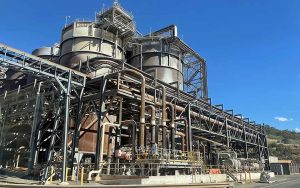Can hydrogen slash alumina refining emissions?
ARENA is backing a groundbreaking trial which could help decarbonise a major Australian industry and source of greenhouse gas emissions.

Australia is a global leader in alumina refining.
Not only a leader in terms of production – Australia is the world’s largest exporter of alumina, the mineral feedstock for aluminium production – but also in tackling emissions from the energy–intensive industry.
In November 2022, ARENA, in collaboration with Deloitte and in consultation with alumina refiners Rio Tinto, Alcoa and South 32, published A Roadmap for Decarbonising Australian Alumina Refining.
The report identified four key decarbonisation technologies: mechanical vapour recompression (MVR), electric boilers, electric calcination and hydrogen calcination.
Now, ARENA is helping a world-first trial to demonstrate renewable hydrogen calcination.
ARENA is providing funding of $32.1 million to Rio Tinto and global trading and business investment company Sumitomo Corporation to develop the $111.1 million Yarwun Hydrogen Calcination Pilot Demonstration Program.
The project will build a 2.5 MW on-site electrolyser to supply renewable hydrogen to the existing Yarwun Alumina Refinery in Gladstone, Queensland. It will also retrofit of one of the refinery’s four calciners to operate with a hydrogen burner.
Sumitomo Corporation will own and operate the electrolyser at Yarwun site and supply the hydrogen to Rio Tinto directly. The electrolyser will have a production capacity of more than 250 tonnes of hydrogen annually.
Potential ‘global impact’

If successful, the project will demonstrate an opportunity to reduce emissions from alumina refining by a whopping 30 per cent. And that is significant because the industry as a whole is responsible for about 3 per cent of Australia’s emissions.
ARENA CEO Darren Miller at the on-site launch of the trial said the Yarwun project could pave the way for adoption at scale across other alumina refineries.
“The six refineries in Australia, with 13 million tonnes or so of emissions, emit more than [the 10 million tonnes] we emit in all of our homes [in Australia],” Mr Miller said.
“You really have to look behind the scenes at refineries like this … to understand the sheer impacts and importance of decarbonising this kind of facility.
“This is the world’s first trial of this technology in a refinery, and if it works here it can work in other places. It can be deployed internationally.
“So not only are we making a difference to this refinery, we could also be making a global impact.”
What is hydrogen calcination and why is it important?

Let’s start with the term “calcination”.
Alumina refineries take bauxite ore through two main processes:
- the Bayer process extracts alumina hydrates, or alumina chemically attached to water molecules;
- calcination drives off the water molecules at temperatures above 1000 degrees C to leave pure alumina.
The high temperatures required for calcination have been achieved by burning fossil fuels, most often natural gas.
So, the hunt is on for alternative, renewable fuels.
One option is to power the calcination furnaces with renewable electricity. Electric calcination is an efficient process, but it can’t easily be retrofitted to existing plant. That means installing expensive new equipment
Step up renewable hydrogen derived from electrolysis of water.
Producing and then burning hydrogen is less energy efficient than electric calcination. But replacing a natural gas burner with a hydrogen equivalent is both technically feasible and emissions free. Burning hydrogen burnt with oxygen means that the only byproduct is water in the form of steam.
If this steam is captured using MVR, it could potentially be recycled into the Bayer process. That would improve energy efficiency, reduce steam production and cut water consumption.
ARENA has also provided funding to Alcoa to investigate electric calcination and trial mechanical vapour recompression.
Real-world application
Minister for Climate Change and Energy Chris Bowen said innovative technology such as the Yarwun hydrogen project is critical for decarbonising heavy industry.
“This ground-breaking project could pave the way for hard-to-abate sectors to reduce their emissions and help make net zero a reality for Australia,” Minister Bowen said.
Rio Tinto Aluminium Pacific Operations Managing Director Armando Torres said: “This pilot plant is an important step in testing whether hydrogen can replace natural gas in Queensland alumina refineries.”
Sumitomo Corporation Energy Innovation Initiative Director, Seiji Kitajima said: “We are excited to be delivering this hydrogen project together with Rio Tinto as our long-term partner with the support of ARENA.”
“Demonstrating real-world applications of hydrogen in industrial settings with motivated partners is essential to reducing carbon emissions,” he said.
If the trial is successful, converting the whole Yarwun site to use green hydrogen could cut emissions by 500,000 tonnes per year. That is the equivalent of taking about 109,000 internal combustion engine cars off the road.
Construction will start in 2024 with operations at the hydrogen plant and calciner expected to begin by 2025.
LIKE THIS STORY? SIGN UP TO OUR NEWSLETTER

ARENA